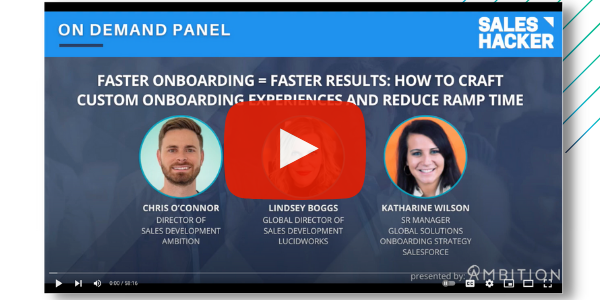Ambition sponsored a recent Sales Hacker webinar on efficiently ramping new reps. Our own Director of Sales Development, Chris O’Connor, participated in the panel discussion along with other revenue leaders from Lucidworks and Salesforce.
FIRST, SOME ONBOARDING BASICS
Fast onboarding for the sake of fast onboarding alone is not the goal. Your goal is to reduce ramp time by unlocking the full productivity of your new reps sooner. The panelists all agree your best shot at success is a custom onboarding experience that utilizes the following strategies:
- Go hybrid. Chris recommends you start week one with a playbook that outlines the critical procedures necessary for success in the role. Based on discovery from week one, launch into week two with a plan tailored to the individual that addresses their specific strengths and weaknesses. You should also start shadowing and roleplaying for as many low-risk at-bats as possible in the second week.
- Have a control. Katharine Wilson (Sr. Manager Global Solutions Onboarding Strategy at Salesforce) stresses the importance of a controlling variable—such as the curriculum—in your onboarding process. “Keeping some things the same across the board allows you to see how different personalities and different levels of experience come into play.”
- Start small. Lindsey Boggs (Global Director of Sales Development at Lucidworks) reminds us that new sales reps right out of college or fresh from another industry may need a crash course in personal branding, business acumen, technology, or acronyms. Sometimes your reps just need to feel like they’re moving the needle early on.
- Onboard in cohorts—For so many reasons, if possible. Not only does onboarding in cohorts create a sense of camaraderie from the start, it’s also scalable. That and it gives you more practice at refining your onboarding process. Cohorts also create the opportunity for competitions against some more veteran reps.
Related: According to The Bridge Group, an average SDR ramp time takes around 3.2 months. We’ve provided three ways you can calculate your own sales team’s ramp up time.
THE BUDDY SYSTEM WORKS
With a caveat. Pairing an SDR with an AE or AE with a SM is a great strategy; however, it must be organic. Lindsey at Lucidworks says her pairings have been the most effective when she’s had SDRs reach out to all of the AEs and pair with someone they align with the most. Forced mentorship pairings tend to not stick on either end.
The buddy system can be an especially powerful strategy if you are working with a highly technical product with multiple offerings and need the support of someone more knowledgeable. Chris adds that the buddy system is especially valuable with the rise of remote work. Gone are the days when you could simply swivel in your chair to ask a coworker the answer to a question you may be too intimidated to send to your manager over Slack.
Katharine at Salesforce swears by the buddy system. And she doesn’t stop at one buddy: she believes the best way to create stickiness for new reps is to create an organic network for them spread across the company. She says it’s important for new reps to feel connected to the company from day one as it “fosters a culture of inclusivity and learning from the get-go.” She also leverages the buddy system as a leadership test of someone who wants to be in management by offloading some onboarding onto that person.
YOUR TECH STACK SHOULD WORK FOR YOU
Businesses have their pick when it comes to what programs and applications they can utilize to organize and track tasks and performance. And with hybrid, at-home offices, tech stack choices continue to grow and improve, making it more difficult to know what tool will suit your team best. Chris lays out three practices he implements with each new SDR using Ambition software:
- Measure your success. At Ambition, reps have a clear, daily, weighted Sales Rep Scorecard that allows them to understand the difference between a good day and a bad day from day one. Our scorecards automatically provide performance visibility with easy-to-understand daily or weekly quotas and all the essential KPIs.
- Celebrate early wins. It may take up to a month for a rep to land their first meeting. This can cause them to feel that they are bad at sales when it’s too early to even know. Set up alerts with Sales Leaderboard Software so the whole team can share and celebrate when new reps hit certain milestones.
- 1:1 Coaching. Always track progress, review relevant call recordings, and ask your rep how they feel about particular KPIs or interactions. Ambition’s Sales Coaching Software can enable managers to run individual or team coaching sessions, lead action plans, take notes, and more.
ESTABLISH FEEDBACK LOOPS
Fast and efficient onboarding hinges on a culture of productive feedback and question-asking. The panelists all agree it’s critical to set the tone for feedback on day one: be willing to accept and provide feedback in a safe and open space. Chris and Katherine intentionally build in time for reps to ask any question, big or small. Feedback loops are essential to shrinking ramp times.
 Back
Back





